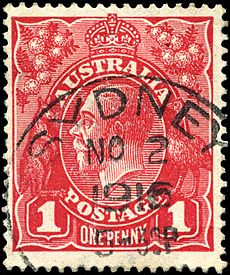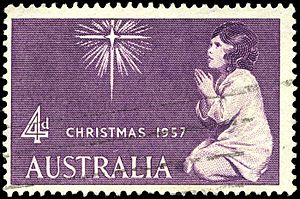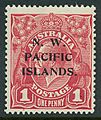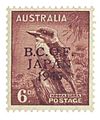Postage stamps and postal history of Australia facts for kids

This article tells the story of postage stamps and how mail was handled in Australia. You'll learn about the first stamps, special designs, and how the postal system changed over time.
Contents
- Australia's Early Postal History
- The Famous "Roo" Stamp
- Later Stamp Designs
- First Commemorative Stamps
- Airmail Stamps
- Stamp Booklets
- Self-adhesive Stamps
- Postal Rates and Special Stamps
- Joint Stamp Issues
- Postal Stationery
- External Territories' Stamps
- Stamps from Military Occupations
- Images for kids
Australia's Early Postal History
Before 1901, Australia was made up of six separate colonies. Each colony had its own postal service and printed its own stamps. For example, New South Wales started issuing stamps in 1850, and Victoria followed in the same year. Tasmania began in 1853, Western Australia in 1854, South Australia in 1855, and Queensland in 1860.
On January 1, 1901, these six colonies joined together to form the Commonwealth of Australia. The new Australian government took over all postal, telegraph, and telephone services.
The Commonwealth's new postal department, called the Postmaster-General's Department, started on March 1, 1901. Even after this, the old colony stamps were still valid and could be used. They were accepted until February 14, 1966, when Australia switched to decimal currency (dollars and cents) and all old stamps became invalid.
It took some time to create new, uniform stamps for the whole Commonwealth. However, the first "Postage Due" stamps, which are used when someone hasn't paid enough postage, were issued in July 1902. Their design was similar to the old New South Wales postage due stamps.
On May 1, 1911, postal rates became the same across all the new Australian states. This was because Australia joined the Imperial Penny Post system, which meant you could send a letter for just one penny within the British Empire. So, one penny became the standard price for sending a letter within Australia. In the same year, a competition was held to design new stamps for the Commonwealth. Over a thousand people entered!
The Famous "Roo" Stamp

Many people consider the real start of Australian stamp collecting to be January 2, 1913. This is when the first red 1d (one penny) Kangaroo and Map stamp was released. This design was partly inspired by an entry from the stamp design competition. It was the first official stamp to simply say "Australia" on it.
The first set of these "Kangaroo and Map" stamps included fifteen different values, from ½d (halfpenny) to £2 (two pounds). The Fisher Labor Government ordered this design. Some members of this government didn't want the King's picture on Australian stamps.
However, a new government, the Cook Liberal Government, took over on June 14, 1913. One of their first decisions was to order new stamps featuring the profile of King George V. The first of these, a 1d carmine-red stamp, came out on December 8, 1913. Soon after, other values with King George V's picture were released. The Postmaster-General's Department decided to keep both the Kangaroo and Map design and the King George V design in use for many years. The Kangaroo and Map design was used for 38 years, and the King George V design for 23 years!
Later Stamp Designs
From 1936, when King George VI became monarch, until the early 1970s, Australian stamps often showed the monarch, but also featured Australian animals and Australian plants. By the late 1950s, the monarch (now Elizabeth II) mostly appeared on stamps for the cheapest letter rates.
When Australia switched to decimal currency on February 14, 1966, 24 new stamps were issued. The monarch was on the lowest values (1c to 3c) and the basic letter rate (4c). Other stamps showed Australian birds, Australian marine life, and early Australian explorers. Interestingly, if an old stamp had a direct value conversion, its design was kept but the value changed. For example, the 2/6d (two shillings and sixpence) Scarlet robin stamp became the new 25c stamp.
The last basic letter stamp featuring the monarch was issued on October 1, 1971. Since then, Australian stamps have mostly shown animals, plants, marine life, gemstones, paintings, and other aspects of Australian culture and community. Since 1980, a special stamp has been issued every year to celebrate the monarch's birthday.
First Commemorative Stamps
Australia's very first commemorative stamp was released on May 9, 1927. It celebrated the opening of the first Parliament House in Canberra. After that, special stamps were regularly issued to mark important Australian achievements and historical events.
The first Australian stamps with multiple colours appeared on October 31, 1956. These were part of the special issue for the Melbourne Olympic Games. They were printed by a company from another country. The first multicoloured stamp printed in Australia was issued on September 5, 1962. It celebrated the 50th anniversary of the Australian Inland Mission.
There have been many other special stamps. The first Christmas stamp came out on November 6, 1957. In recent years, Christmas stamp designs have switched between religious and non-religious themes each year. Since 1993, every October, Australia Post has celebrated Stamp Collecting month with special issues. These often feature topics that children enjoy, like pets, native animals, and space. Also, since the Sydney Olympic Games in 2000, stamps featuring Australians who win an Olympic gold medal are issued on the very next business day after their win!
Airmail Stamps
Australia's first stamp specifically for airmail was released on May 20, 1929. It was a special 3d (three pence) airmail stamp for mail sent on the Perth-Adelaide air service. This service cost 3d plus the normal postage. Two more airmail stamps, both 6d (sixpence), appeared in 1931. After these, regular stamps were used for mail sent by air.
Stamp Booklets
Coin-operated vending machines that sold stamps were introduced in 1960. They are still around today in different forms. These included special Frama vending machine stamps, which were issued from 1984 to 2003, and various booklets. Stamp booklets were stopped in 1973 but brought back later. Some stamp booklets were even available from Advance Bank ATMs from 1984 until 1996. Australia also had its first (and so far only) triangular stamp issue during this time.
Self-adhesive Stamps
Self-adhesive stamps, which you just peel and stick, were first issued in 1990. The first self-adhesive commemorative stamps appeared in 1993. These stamps became very popular and are now used more often than traditional gummed stamps. Australia still issues gummed versions of all self-adhesive stamps.
Before 1997, the only living people who could appear on Australian stamps were the reigning monarch and other members of the British Royal Family. But since 1997, Australia Post has issued stamps celebrating living Australians. There's an annual "Australian Legends" series that honours Australians who have made important contributions to the country.
Stamps with personalized tabs were introduced in 1999. Australia Post also uses these tabs to celebrate themes or individuals that might not get their own full stamp issue.
Postal Rates and Special Stamps
Since the introduction of the Goods and Services Tax (GST) in 2001, Australia has had separate stamps for domestic (within Australia) and international (overseas) mail. Stamps marked "International Post" cannot be used for mail within Australia. You can use domestic stamps for overseas mail, but their value is slightly less because of the tax.
From 1913 to 1930, government departments used stamps that were "perfined" with "OS" (meaning "Official Service"). This meant small holes were punched into the stamps to show they were for official use. In 1931, the punching stopped, and stamps for government mail were overprinted with "OS." By February 1933, government mail no longer needed stamps at all. The only exception was a 6d airmail stamp from November 4, 1931, which was overprinted "OS" but sold to the public to prevent people from trying to make money from it, and it could be used for any type of mail.
Joint Stamp Issues
Australia has created special joint stamp issues with other countries. This means they release stamps with a similar theme or design at the same time. Australia has done this with:
- New Zealand (1958, 1963, 1988)
- The United Kingdom (1963, 1988, 2005)
- Some of its external territories (1965)
- The United States of America (1988)
- The U.S.S.R. (1990)
- People’s Republic of China (1995)
- Indonesia (1996)
- Singapore (1998)
- Greece (2000)
- Hong Kong (2001)
- Sweden (2001)
- France (2002)
- Thailand (2002)
Postal Stationery
Postal stationery refers to items like postcards, envelopes, and letter cards that already have a stamp design printed on them. The Commonwealth of Australia first issued these in April 1911. Postcards and letter cards featured a design of King George V. Envelopes, registered envelopes, and Newspaper wrappers (for sending newspapers) were first issued in 1913, using the "Kangaroo on Map" stamp design. Aerogrammes, which are lightweight sheets of paper that fold into their own envelope for airmail, were first issued in 1944.
External Territories' Stamps
Australia has several external territories, and each has its own postal history.
Norfolk Island used stamps from New South Wales after 1877. Then, it used Australian stamps between 1913 and 1947. On June 10, 1947, Norfolk Island started issuing its own stamps.
The Territory of Papua, which was a British colony but managed by Australia, issued its own stamps from 1901. Before that, it used Queensland stamps. Australian stamps were used there between 1945 and 1953 in the new Territory of Papua and New Guinea.
Christmas Island and Cocos (Keeling) Islands were transferred from Singapore to Australia in the 1950s. They gradually became part of the Australian postal system. Christmas Island had its own stamps from 1958 until 1993. The Cocos Islands used Australian stamps from 1952 until they got their own stamps in 1963, which they used until 1994. When they lost their postal independence, their stamps became valid in Australia, and Australian stamps became valid in the islands.
The Australian Antarctic Territory has always used Australian stamps, but it started issuing its own special stamps on March 27, 1957. These stamps are also valid for postage within Australia.
Stamps from Military Occupations
During World War I, Australia took control of two former German colonies: German New Guinea and Nauru (part of the German Marshall Islands). Stamps from these German colonies and from the United Kingdom were overprinted (had new text printed on them). In the 1920s, Australia issued stamps in the name of these two territories as part of its duties under League of Nations mandates. After Japan occupied Nauru and New Guinea, Australian stamps were used from late 1945 until new Nauru stamps were available.
In the Territories of Papua and the mandate of New Guinea, Australian stamps were valid between 1945 and 1953. When they joined to become the new Territory of Papua and New Guinea, they received their own stamps from Australia until they became independent in 1975.
Between October 1946 and February 1949, in occupied Japan, Australian stamps used by military post offices were overprinted with "B.C.O.F. / JAPAN / 1946." This was done to prevent people from misusing the currency.
Images for kids







